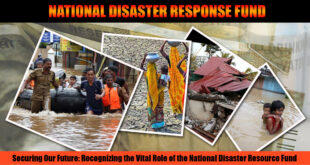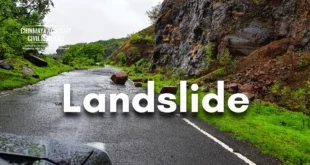Cracks first appeared in a few houses in Uttarakhand’s Joshimath town in October 2021. Over a year later, by January 11, 2023, 723 houses in all of the nine wards in the town had developed major or minor cracks on the floors, ceilings and walls. In response, 145 families have been temporarily moved to safer locations within the town.
Where is the town of Joshimath situated?
- At a height of 6,107 feet, Joshimath is a busy town in the Chamoli district of Uttarakhand. Despite a population of only about 23,000, it has been heavily built-on, with hotels, resorts, and a bustling market that caters mainly to tourists, pilgrims, trekkers and personnel of the Army and the Indo-Tibetan Border Police (ITBP).
- After the 1962 India-China war, Joshimath emerged as a place of strategic importance as it leads to villages along the India-China border.
- It is also en route to Barahoti, a disputed territory along the border. The town is also a gateway to noted sites of pilgrimage — Badrinath for Hindus and Hemkund Sahib for Sikhs; the international skiing site of Auli; and the Valley of Flowers, a UNESCO World Heritage site.
- However, today, Joshimath is overly burdened with structures built without any regard for the land’s load-bearing capacity.
How vulnerable is Joshimath?
- Joshimath’s geological setting, together with the unplanned and rampant construction in and around the town, has resulted in land subsidence.
- The signs of sinking first appeared in October 2021, when 14 families in the Chhawani Bazar locality noted cracks in their houses. Subsequently, cracks continued to appear around town and residents resorted to repairs.
- The situation became particularly alarming towards the end of 2022 and the beginning of 2023, when large parts of the town experienced sudden land-sinking and several houses developed major cracks.
- Joshimath is built on the deposits of an old landslide, which means that the slopes can be destabilised even by slight triggers.
- The town is also in Zone V, which, as per India’s seismic zonation scheme, denotes the highest risk. It lies between two thrusts, the Main Central Thrust (MCT) and the Vaikrita Thrust (VT), and thus occupies a seismically active terrain. Geologist Navin Juyal, who conducted research on land subsidence in the town in 2022, said that because of the MCT, the area around Joshimath is highly active in terms of slope mobility.
- Joshimath is also prone to extreme weather. “Climatologically, Joshimath lies in a region that frequently receives high-intensity, focussed rainfall,” Mr. Juyal said. Extreme rains, for example, could trigger landslides, since the slopes are precariously balanced, he said.
- A report on Joshimath published by the Uttarakhand State Disaster Management Authority (USDMA) in September 2022 said that the floods of June 2013 and February 2021 heightened erosion in the area.
- Very heavy rains in October 2021 — 190 mm in 24 hours — worsened the subsidence and vulnerability to landslides, it stated.
- Land subsidence was noticed in the area decades ago. The then Uttar Pradesh government (Uttarakhand was then a part of Uttar Pradesh) formed a committee led by M.C. Mishra to study its causes.
- The committee’s report of 1976 warned against heavy and unscientific construction in the town, writing: “Joshimath is a deposit of sand and stone … hence was not a suitable place for the coming up of a township.
- Vibrations produced by blasting and heavy traffic will also lead [to] disequilibrium in natural factors.” However, Joshimath continued to develop exactly the way the Mishra committee had advised against.
What is the role of the NTPC?
- Locals have blamed the National Thermal Power Corporation’s (NTPC) 520-MW Tapovan Vishnugad hydropower project, under construction in the area, for exacerbating Joshimath’s land subsidence.
- On December 24, 2009, a tunnel boring machine punctured an aquifer some three km from Selang village, which is only about five km from Joshimath.
- The tunnel is nearly a kilometre under Auli, near Joshimath.
- The puncture released water at 700-800 litres per second, enough to meet the needs of at least two million people every day, as per a 2010 article by researchers affiliated with the Dehradun-based Uttarakhand Disaster Mitigation and Management Centre and the Srinagar Garhwal-based Hemvati Nandan Bahuguna (HNB) Garhwal University.
- Additionally, while the amount of discharge has reduced over the years, it has still not stopped, stated Puran Billangwal (43), another Joshimath resident.
- Atul Sati, convener of the Joshimath Bachao Sangharsh Samiti, which has been protesting against projects detrimental to Joshimath since 2004 and is currently leading protests demanding adequate relief and rehabilitation for Joshimath’s residents whose houses have been damaged, believes that the water released in 2009 is a major contributor to the subsidence.
- This month, water laden with muck and some volatile chemicals, began surfacing in the town’s Marwari ward.
- “Several of us believe the water is from the February 7, 2021 flood that would have entered into the (under-construction) tunnel of the Tapovan Vishnugad project and is now surfacing in Joshimath,” Mr. Sati said, adding that the water has been sent to Dehradun for tests.
- However, there have been no scientific studies establishing links between the puncture and the subsidence in Joshimath. Therefore, the NTPC in a January 5 press release denied any role in the ongoing crisis.
What about the Char Dham project?
- The six-km Helang-Marwari bypass, being built by the Border Roads Organisation (BRO), is also under scrutiny for weakening slopes and further destabilising the local topography.
- The bypass is part of the 825-km Char Dham highway expansion project in Uttarakhand, which experts have already questioned for unscientific slope-cutting, which resulted in several landslides.
- Juyal, the geologist, was a former member of the High Powered Committee that the Supreme Court appointed to review the project.
- He had recommended that the bypass be built only after a geotechnical feasibility study. He told The Hindu that the project was built despite warnings from a few committee members. Residents stated that the BRO was using drills and explosives to construct the bypass.
- Yaspal Sundriyal, a geologist at the HNB Garhwal University who has studied land subsidence in Joshimath, said, “Heavy construction work for the road is weakening the foundations on which Joshimath stands. It could be detrimental to the town’s existence.”
- On January 5, the Chamoli district administration temporarily halted work on the bypass and the NTPC dam in a desperate bid to slow the subsidence.
What are the other issues which have contributed to land subsidence?
- The 2022 USDMA report also pointed to a lack of drainage and wastewater disposal systems as being part of the subsidence problem. According to Mr. Sati, about 85% of buildings in the town — including those owned by the Army — aren’t connected to a sewerage system and have soak pits instead.
- The 1976 Mishra committee report had warned that these pits could create “cavities between soil and boulders”, as well as that inadequate drainage could lead to landslides. Garhwal University’s Mr. Sundriyal has said that such cavities result in land subsidence as well.
SOURCE: THE HINDU, THE ECONOMIC TIMES, PIB
 Chinmaya IAS Academy – Current Affairs Chinmaya IAS Academy – Current Affairs
Chinmaya IAS Academy – Current Affairs Chinmaya IAS Academy – Current Affairs



